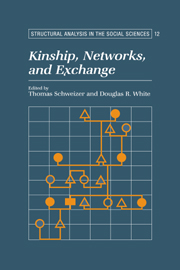Book contents
- Frontmatter
- Contents
- Preface
- List of contributors
- 1 Revitalizing the Study of Kinship and Exchange with Network Approaches
- I Representing Kinship Dynamics, Material Flow, and Economic Cooperation
- 2 The Grapevine Forest: Kinship, Status, and Wealth in a Mediterranean Community (Selo, Croatia)
- 3 Kinship, Property Transmission, and Stratification in Javanese Villages
- 4 Network Mediation of Exchange Structures: Ambilateral Sidedness and Property Flows in Pul Eliya (Sri Lanka)
- 5 Alliance, Exchange, and the Organization of Boat Corporations in Lamalera (E. Indonesia)
- II Individual Embeddedness and the Larger Structure of Kinship and Exchange Networks
- III Marriage, Exchange, and Alliance: Reconsidering Bridewealth and Dowry
- IV Emergence, Development, and Transformation of Kin-Based Exchange Systems
- Index
4 - Network Mediation of Exchange Structures: Ambilateral Sidedness and Property Flows in Pul Eliya (Sri Lanka)
Published online by Cambridge University Press: 05 November 2011
- Frontmatter
- Contents
- Preface
- List of contributors
- 1 Revitalizing the Study of Kinship and Exchange with Network Approaches
- I Representing Kinship Dynamics, Material Flow, and Economic Cooperation
- 2 The Grapevine Forest: Kinship, Status, and Wealth in a Mediterranean Community (Selo, Croatia)
- 3 Kinship, Property Transmission, and Stratification in Javanese Villages
- 4 Network Mediation of Exchange Structures: Ambilateral Sidedness and Property Flows in Pul Eliya (Sri Lanka)
- 5 Alliance, Exchange, and the Organization of Boat Corporations in Lamalera (E. Indonesia)
- II Individual Embeddedness and the Larger Structure of Kinship and Exchange Networks
- III Marriage, Exchange, and Alliance: Reconsidering Bridewealth and Dowry
- IV Emergence, Development, and Transformation of Kin-Based Exchange Systems
- Index
Summary
Our aim, by means of the richly documented example of Pul Eliya (Leach 1961 [1968]), is to examine the relationship between certain kinship phenomena (pertaining to the circulation of persons) and certain aspects of economic exchange (pertaining to the circulation of things) from a network analysis perspective. In doing so, we hope to demonstrate the relevance of a particular approach to alliance relations – one very much in keeping with Leach's work – in which primary emphasis is given to actual marriage ties and structure is conceived above all as an emergent patterning of the marriage network as a whole.
From 1935 through the 1950s, British Social Anthropology, most notably in the works of Radcliffe-Brown, Evans-Pritchard, and Fortes, exhibited a strong bias both toward exclusive emphasis on inheritance and descent in defining corporate kinship groups and toward defining such groups as the basis for human kinship systems. Leach's study of Pul Eliya was notable for showing how to correct for the bias of descent theory by examining locality as well as cooperative links among families which serve as an economic basis for kinship groups and patterns of kinship behavior. He was concerned with the use of a kinship idiom as a means of organizing cooperative labor, as well as with demonstrating empirically that kinship is structured both by the organization of property rights linked to land and water in irrigation agriculture and by the procedures by which they are inherited.
- Type
- Chapter
- Information
- Kinship, Networks, and Exchange , pp. 59 - 89Publisher: Cambridge University PressPrint publication year: 1998
- 8
- Cited by

